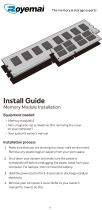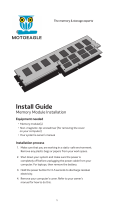
3User's Manual | OPS150-CS
Table of Contents
Chapter 1 - Introduction................................................................................................................6
Specifications ......................................................................................................................... 6
Features .................................................................................................................................. 7
DDR4 ................................................................................................................................. 7
Chapter 2 - Hardware Installation ................................................................................................8
Overview .................................................................................................................................. 8
Front Panel ....................................................................................................................... 8
Rear Panel I/O ..................................................................................................................8
Top and Side View ...........................................................................................................8
Bottom View.....................................................................................................................8
Dimensions ...................................................................................................................... 8
Installation .............................................................................................................................. 9
Mounting into OPS Display ............................................................................................. 9
Assembly ..............................................................................................................................10
Top Cover .......................................................................................................................10
Heatsink and Fan ...........................................................................................................11
Module Bracket .............................................................................................................. 15
System Board .................................................................................................................15
Board Layout.........................................................................................................................16
LEDs ......................................................................................................................................16
System Memory ...................................................................................................................17
Installing the SO-DIMM Module ...................................................................................17
CPU ........................................................................................................................................19
Installing the CPU ..........................................................................................................19
Jumper Settings ...................................................................................................................21
Clear CMOS (JP1) .........................................................................................................21
I/O Ports ................................................................................................................................22
Graphics Display ............................................................................................................22
USB Ports ....................................................................................................................... 22
RJ45 LAN Ports ............................................................................................................. 23
COM (Serial) Port ..........................................................................................................23
Audio ...............................................................................................................................24
LPC .................................................................................................................................24
Battery ............................................................................................................................25
CPU Fan ..........................................................................................................................25
Expansion Slots .............................................................................................................26
Installing the M.2 Module .............................................................................................26
Installing the Wifi Antenna for the M.2 E Key Wifi Module (Optional) ...................... 27
OPS Display ....................................................................................................................28
Chapter 3 - BIOS Settings ...........................................................................................................29
Overview ...............................................................................................................................29
Main .......................................................................................................................................30
Advanced .............................................................................................................................30
RC ACPI Configuration ..................................................................................................31
CPU Configuration .........................................................................................................31
Power & Performance ...................................................................................................32
PCH-FW Configuration ..................................................................................................32
Trusted Computing ........................................................................................................33
NCT5525D Super IO Configuration ..............................................................................33
NCT5525D HW Monitor ................................................................................................34
Serial Port Console Redirection ...................................................................................35
USB Configuration .........................................................................................................36
CSM Configuration ........................................................................................................37
USB Power Control ........................................................................................................37
Network Stack Configuration........................................................................................38
Chipset ..................................................................................................................................39
Graphics Configuration .................................................................................................39
PCH-IO Configuration ....................................................................................................40
PCI Express Configuration ............................................................................................ 40
SATA And RST Configuration .......................................................................................41
HD Audio Configuration ................................................................................................41
Security .................................................................................................................................42
Secure Boot ....................................................................................................................42
Boot .......................................................................................................................................43
Save & Exit ............................................................................................................................43
Updating the BIOS ................................................................................................................ 44
Notice: BIOS SPI ROM..........................................................................................................44
Chapter 4 - Supported Software ................................................................................................ 45
Auto-run Menu ......................................................................................................................45
Intel Chipset Software Installation Utility ...........................................................................45
Intel HD Graphics Drivers ...................................................................................................46
Realtek Audio Drivers ...........................................................................................................47
Intel ME Drivers ....................................................................................................................48
Intel Serial IO Drivers ...........................................................................................................49
Intel Rapid Storage Technology .........................................................................................50
Intel Wi-Fi Drivers .................................................................................................................52
Intel Bluetooth Drivers .........................................................................................................53
Realtek LAN Driver ..............................................................................................................54
Adobe Acrobat Reader 9.3 ..................................................................................................55





















